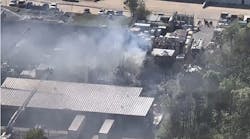Since day one in the fire service, we are inundated with education. As trainees, we receive our first introduction to ICS. Whether we are training on departmental standard operations guidelines (SOGs) or attending degree programs or technical rescue classes, the common element is a refresher or focus on the design and basic implementation of the ICS. The success or failure of any incident is attributed to the strategies and tactics utilized. As firefighters, we are vital in the implementation of the tactics, and we have a big impact on the strategies. We influence those strategies and the ICS.
I am fortunate to work for a department that takes an aggressive approach and implements the ICS at all incidents. Beyond that, we work closely with several other departments that take the same approach with emergency response. Because of this approach, the various departments work well together. Our success at incidents is due in a large part to knowledgeable and experienced command officers, but also a deep understanding of the ICS and the role firefighters play as individuals at the bottom of the ladder.
One of the most important things to remember regarding ICS is the dissemination of information throughout the ranks. Obviously the incident commander (IC) does the majority of the communicating, with orders flowing to other sections or sectors. However, decisions require that valuable information is readily supplied to the IC – the general rule is that orders flow down, and information must flow up.
Stationed at the command post, the IC has a limited view of the scene and no personal knowledge of inside conditions. This is the reason why firefighters must provide accurate information. If we are making an aggressive interior attack and conditions appear to be deteriorating (heat increasing, visibility becoming worse), we recognize that we may want to change our tactics. We need to advise the IC about what we are experiencing. As firefighters and company officers, we need to be able to communicate with the IC. We are the “eyes and ears” of the IC. For good, effective command decisions to be made, the incident commander needs all the information. Firefighters need to relay concerns or observations to their officers to ensure that all pertinent information reaches the command post.
Another issue that can easily deteriorate an otherwise successful operation is a firefighter’s ego, or sense of pride. The practice of pushing too hard for too long simply to prove how tough we are can easily undermine a commander’s efforts and injure firefighters. We need to watch ourselves closely. If we are advancing into a large commercial structure for 10 minutes, we don’t need to wait for our bells to start ringing before we decide to back out.
A lost, injured or trapped firefighter dramatically changes the face of an incident. The IC is now forced to utilize crews to rescue the member in trouble. An aggressive attack on the fire turns into a firefighter rescue. The effectiveness of every member on scene has now dramatically decreased in respect to our efforts of the initial incident. Members are focusing on what they can do to help the member in trouble. When firefighters are injured, strategic and operational focus is immediately diverted to “rapid intervention,” drastically altering the IC’s plans.
I have seen ICS succeed at many incidents, large and small. For example, my department responded to a fire in a six-story retirement facility. This building was not sprinklered and had a high occupancy of elderly and handicapped individuals. The fire started on the fourth floor, and involved only one apartment. Heavy smoke spread through the structure due to an open atrium from the first floor to the roof. The incident required four alarms, with the majority of personnel being used to help treat the occupants and assist them in getting out of the building.
Coordination between the agencies on scene, which included multiple fire companies from several departments, EMS rigs and supervisors, law enforcement, utility companies, and facility managers, was a difficult task. By utilizing the ICS effectively, sector chiefs and safety officers were established at key locations. The fire was not allowed to extend and was extinguished quickly. Everyone on the scene clearly understood their responsibilities and assignments because we used the ICS.
I have also seen incidents where the ICS was utilized with less favorable outcomes. A structure call came in for a row of townhouses. The first-arriving units reported heavy smoke showing from one of the end units. Eventually, the incident went to multiple alarms. The fire damaged five of the six units before being extinguished. The command post was established in the best possible location available. From that position, heavy smoke was visible with other factors that made the fire appear to be spreading through the attic. Aggressive attempts were made to gain access to the attic and contain the fire.
In the critique following the incident, a video taken by an off-duty firefighter was utilized to review the tactics applied. The video showed the fire aggressively consuming the balconies in the rear of the structure, and spreading up and into the eaves. This fire behavior had been observed by several people during the incident, but the incident commander was never made aware of it. Everyone on scene assumed he knew about it. This lack of information affected the IC’s operational strategy.
The incident command system does not put all the “power” in the hands of the incident commander. However, when things go bad, it is the IC who must accept most of the blame. The incident command system gives the IC the authority to make the decisions, but firefighters are also empowered.
Firefighters and engineers are not simply “grunts on the line.” We have to utilize the ICS at every incident and ensure the success of the system. We can make or break an incident, even if all the right decisions are made. Following every incident, I analyze the overall goal of my assigned task. This allows me to get a better understanding of the importance of every individual on the fireground. If I don’t understand why my crew was assigned certain tasks, I will ask after the fire.
The above examples demonstrate the importance of firefighters in the ICS structure. Not many of us think about the impact of the small things, and the behavior of the individual firefighter. We do not make the decisions, and we may not agree with the decisions that are made, but we enact those decisions. For the ICS to be effective, we must communicate vital information, keep ourselves safe, execute our tasks and skills properly, and understand the importance of individual orders. The incident commander makes the decisions; we make them happen.
Ryan Christen is an engineer with the Ocean City Wright Fire District in Okaloosa County Beach, FL. He and Hank Christen will present “The New ICS – What Does It Mean to Firefighters?” at Firehouse Expo 2004 in Baltimore, July 13-18.




